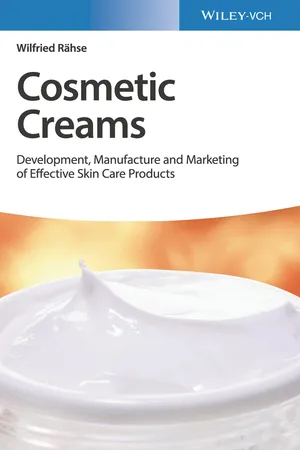1.1 Short Look at the History of Cosmetics
The term cosmetic, originated from the ancient Greek word meaning “order or decorate,” refers to the body and beauty care. This includes the maintenance, restoration, and enhancement of the beauty of human body. The first sign of cosmetics dated back about 10 000 BCE. The Mesolithic people applied grease and castor oil to soften their skin. They painted tattoos with plant dyes. About 7000 years later (3000 BCE), Egyptian parchment described the use of creams to sooth the skin and reduce wrinkles [1]. In the ancient Near East, men applied oils to their hair and beard. Women used eye paints, rouge, powders, and ointments on their body. In 50 BCE, Cleopatra was not only known as a beauty but also known for her intensive use of cosmetics. She possessed many products from nature such as beeswax, honey, and natural oils as well as products made from fruits, vegetables, herbs, and seeds, besides eggs and milk. She bathed in goat milk for skin regeneration. At that time, there were mirrors, makeup, makeup containers, combs, wash dishes, wigs, as well as tweezers and blades for removal of unwanted hair. Vermilion and red ocher were used for coloring the lips and cheeks; henna was used for coloring the hair, skin, toenails, and fingernails; and the malachite green, gray galena, and finely ground antimony were used for eyes as an eyeliner. The Greek physician Galen (about 200 CE) developed the first cold cream from beeswax, olive oil, and water [1]. The Romans introduced communal baths for noble persons. In the Middle Ages, they used hair dye and makeup, in addition to natural skin care and herbal remedies. During those times, a pale complexion was considered beautiful. With white lead, they achieved a flawless pallor. This substance and other cosmetics are highly toxic and often caused abscesses that did not heal. During the Renaissance, the Venetians dyed their hair using plant colors, fixed with clay, and baked in the sun. When it came to Elizabeth I of England (about 1580) and Catherine de Medici in France, dyeing of the cheeks and lips became popular again. The red lip color came from cochineal, a red dye from the cochineal scale insect. In the eighteenth century, bismuth oxide, mercury oxide, tin oxide, and talc were used to whiten the skin. Red makeup for the lips and cheeks emerged from safflower, cochineal, redwood, sandalwood, and vermilion. In addition, the hair was treated with greasy pomades. The hair powder consisted mostly of wheat or rice starch, partly colored. At present, there are ranges of cosmetic products that have been tested for their safe use. The aim has not changed in thousands of years. Primarily, cosmetics mean increasing attractiveness by beautifying the body and face. For a closer look at the historical processes, the following references are suitable [2–4].
1.2 Definition of Cosmetics
The legal text of the European Cosmetics Regulation [5] defines what a cosmetic product is and forms the legal basis in the European Community (EC) for the delimitation to the medical and therapeutic agents. This is the text of (EC) No. 1223/2009, Article 1a (quote): “Cosmetic Product agent any substance or mixture intended to be placed in contact with the external parts of the human body (epidermis, hair system, nails, lips and external genital organs) or with the teeth and the mucous membranes of the oral cavity with a view exclusively or mainly to cleaning them, perfuming them, changing their appearance, protecting them, keeping them in good condition or correcting body odors.”
A very similar definition is given in the German LFGB regulation of 2005 (Lebensmittel‐, Bedarfsgegenstände‐, und Futtermittelgesetzbuch [6]). Text of (GER) LFGB §2, Article 5 (translation): “Cosmetic agents are substances or mixtures of substances exclusively or predominantly intended to be applied externally to the body of the human being or in his oral cavity for cleansing, protecting, maintaining a good condition, for perfuming, changing the appearance or to influence the body odor. Cosmetics are not substances or mixtures of substances which are intended to influence the body forms.”
Already, the revision of the Federal Food, Drug, and Cosmetic Act (FD&C Act) of 1938 described the intended use of these products in a wording [7,8] that is valid until now: (USA, Food and Drug Administration [FDA]) …“(1) articles intended to be rubbed, poured, sprinkled, or sprayed on, introduced into, or otherwise applied to the human body or any part thereof for cleansing, beautifying, promoting attractiveness, or altering the appearance, …” Among the products included in this definition are skin moisturizers, perfumes, lipsticks, fingernail polishes, eye and facial makeup preparations, cleansing shampoos, permanent waves, hair colors, and deodorants, as well as any substance intended for use as a component of a cosmetic product.
Essentially, the purpose of applying cosmetics is to increase the attractiveness of the user. This goal is achieved with many cosmetic products: unobtrusive, barely perceptible in the daily cleaning of skin and hair as well as the teeth, or eye‐catching for decorative cosmetics, hair styling or coloring. To maintain the good condition, the daily use of cosmetic products on the skin and in the oral cavity is necessary; this applies with restrictions also for the hair (nose and ears are not mentioned in the regulation). The main tasks of cosmetics are cleansing, beautifying, perfuming, protecting, and maintaining a good condition of skin, nails, hair, and...
